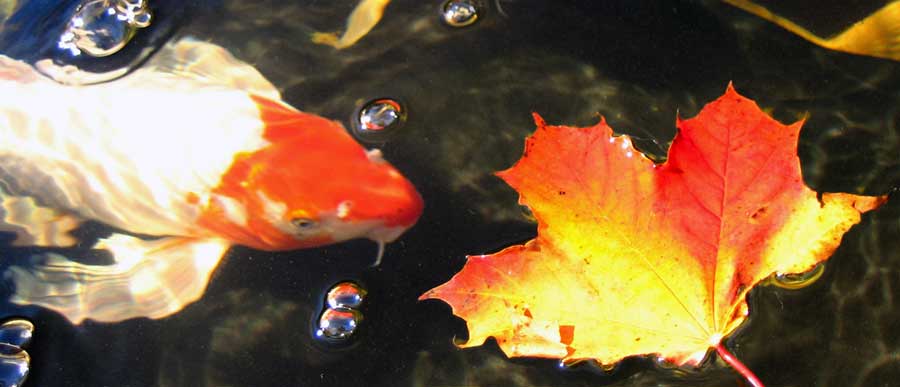
Winters in most of Canada and the northern United States are usually quite long and cold, even without a Polar Vortex! Koi and goldfish are at their most vulnerable during the winter because their metabolisms are slow and their immune systems are very weak. On top of that, the pond water quality has agood chance of becoming unlivable because of low oxygen levels, elevated carbon dioxide, ammonia and nitrite levels. If proper steps aren’t taken in autumn, there is a good chance that your fish won’t survive the winter. However, with some extra planning, care and maintenance you can help ensure your fish thrive through the long winter months.
In autumn, once the water temperature in the pond falls to 64 F / 18 C, begin feeding a Spring & Fall Koi Food. The main ingredients found in these foods is wheat germ, which the fish can digest easily, especially in cold weather. This allows the fish to ‘bulk up’ as much as possible for the long winter when they don’t eat. Stop feeding the fish when the water temperature falls below 48 F / 9 C. Next spring, when the temperature warms up again, begin feeding your fish sparingly with the same food.
Leaves from trees and garden plants that fall in the pond will add tannins to the water making it dark and murky. They will also produce ammonia and nitrite and consume oxygen as they begin to break down and rot. If too many leaves remain in the pond during the winter, the water will become toxic to the fish. It is much easier to place Pond Netting over the pond to keep the leaves out, than having to net them out once they have sunk to the bottom.
Fish waste, dead algae and plant matter can settle on the bottom of the pond and form a layer of sludge. This organic matter can continue to break down during the winter causing the same water quality issues mentioned above. Use a fine mesh Pond Net or Pond Vacuum to remove as much sludge as possible. Another benefit to removing this sludge is reduced algae growth in your pond.
Performing partial water changes (up to 25% at a time) will help to improve water quality by flushing out and lowering nitrates or other unwanted compounds or toxins that may have accumulated in your pond over the summer. Partial water changes also replenish essential minerals that get are used up by the natural processes that occur in the pond. Always remember to use a Dechlorinator is you are on town water.
Cold Water Beneficial Bacteria and enzymes are designed to help maintain optimum water quality in temperatures below 40°F. They also accelerate the breakdown down any remaining leaves, residual sludge and organic matter in the pond during the winter. This helps provide a healthy environment for your fish at a time when they are especially vulnerable.
Pond Salt provides many benefits to koi and goldfish that most people don’t realize. Adding salt to your pond makes osmoregulation easier for fish, it also reducing nitrite toxicity, and fish will also produce a thicker slime coat which protects them from parasites and bacteria. Add 1 to 2 lbs of Pond Salt + Buffer or untreated salt per 100 gallons of pond water. At higher concentrations salt will kill many common parasites.
Keeping an opening in the ice allows oxygen into the pond and noxious gasses such as carbon dioxide out of the pond. If a pond freezes over completely the surface is essentially sealed. The fish will have a limited supply of oxygen that has to last for the entire winter until the ice melts again in the spring. The more fish you have in the pond, the faster the oxygen will run out. Large fish (and usually your favourite fish) are usually the first to die as a result of ow oxygen. We recommend a floating Pond Heater / De-icer combined with an Pond Aerator to maintain a hole(s) through the ice.
For more in-depth information see our How to Winterize Your Pond and How to Build a Winter Pond Cover information pages. Or if you are concerned about leaving you fish in the pond during the winter, you can always bring them inside where you can keep a close eye on them. See our Bringing Koi Indoors For Winter for more information
We have all the Fall and Winter Pond Supplies you need to prepare your pond for winter and help ensure your fish survive.